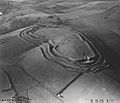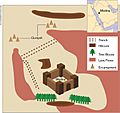Fortress facts for kids
A fortress is a strong building made to be defended. It was built to be very hard for enemies to get inside. Fortresses kept the people living inside safe from attacks.
Fortresses are a lot like castles, but they have some key differences. They usually have very thick stone walls. These walls are often thicker than castle walls, but not as tall. This design helped them stand strong against artillery like cannons.
Contents
What is a Fortress?
Fortresses were built to protect people and important places. They were designed to be very difficult for attackers to capture. The main goal was to keep those inside safe from harm.
How Fortresses Were Built
Fortresses had very small windows, often without glass. These tiny openings were perfect for soldiers inside to shoot arrows or fire guns at enemies. It was very hard for attackers outside to shoot back through such small openings.
Over time, the weapons used in battles changed. Early fortresses faced bow and arrows and crossbows. Later, they had to withstand guns and cannons. The strong walls and small windows helped protect against these changing threats.
Defending a Fortress
Defenders inside a fortress had many ways to fight back. They could drop heavy rocks or even boiling oil onto enemies trying to get close to the walls. This made it very dangerous for anyone trying to attack.
Most successful attacks on a fortress involved a siege. A siege is when an army surrounds a fortress for a long time. They try to cut off supplies like food and water. This forces the people inside to surrender because they run out of resources.
Life Inside a Fortress
Life inside a fortress was not very comfortable. These buildings were made for protection, not for living in luxury. They were often dark, cold, and damp. The Tower of London in England is a famous example of a fortress. It was built to be a strong defensive structure.
Related Pages
Images for kids
-
Castillo San Felipe de Barajas, Colombia. Cartagena's colonial walled city and fortress were designated a UNESCO World Heritage Site.
-
Maiden Castle in 1935. The Iron Age hillfort was first built in 600 BC.
-
Early 20th century aerial photograph of the fortifications of Valletta, Malta which were built in the 16th and 17th centuries
-
Aerial photograph of Fort Vossegat, Utrecht, The Netherlands.
-
Han dynasty tomb brick showing gate towers
-
Han dynasty tomb brick showing watchtowers
-
Remains of a fortified village, Borġ in-Nadur, Malta. Borġ in-Nadur is a notable example of Bronze Age-fortifications.
-
Defensive wall of the ancient city of Dholavira, Gujarat 2600 BCE
-
The Great Wall of China near Jinshanling. The Great Wall was a series of fortifications built across the historical northern borders of China.
-
An American flag raised at the Fort Santiago, 1898. Fort Santiago was a citadel that was a part of the Intramuros, a walled city within Manilla.
-
Medieval defensive walls and towers in Szprotawa, Poland, made of field stone and bog iron.
-
John Smith's 1624 map of the fortifications of the Castle Harbour Islands and St. George's Harbour in Bermuda. Construction beginning in 1612, these were the first stone fortifications, with the first coastal artillery batteries, built by England in the New World.
-
Suomenlinna, a sea fortress from 18th century in Helsinki, Finland
-
The tunnels of Fort de Mutzig, German fortifications built in 1893. By the 19th century, tunnels were used to connect blockhouses and firing points in the ditch to the fort.
-
Gun emplacement in Fort Campbell, built in the 1930s. Due to the threat of aerial warfare, the buildings were placed at a distance from each other, making it difficult to find from the air.
-
Cheyenne Mountain Complex is an underground bunker used by North American Aerospace Defense Command. Cheyenne Mountain is an example of a mid-20th century fortification built deep in a mountain.
-
The Ozama Fortress in Santo Domingo, Dominican Republic is recognized by UNESCO for being the oldest military construction of European origin in the Americas.
See also
 In Spanish: Fortificación para niños
In Spanish: Fortificación para niños
























